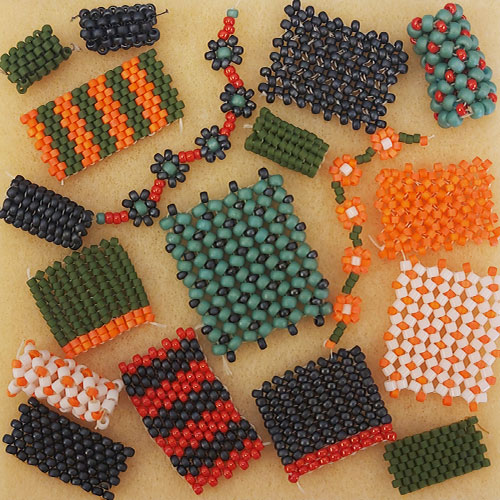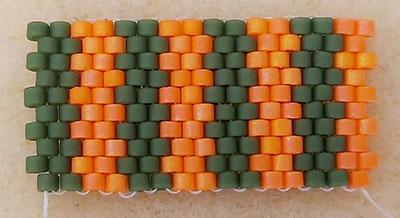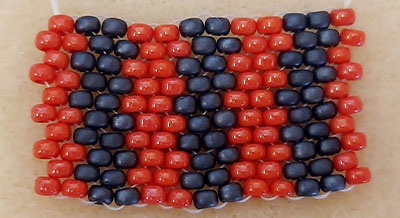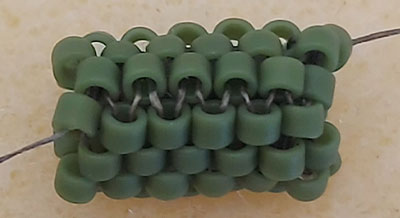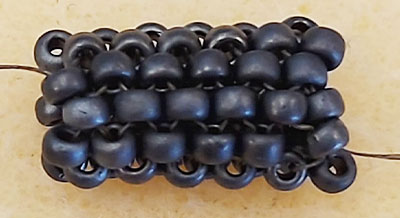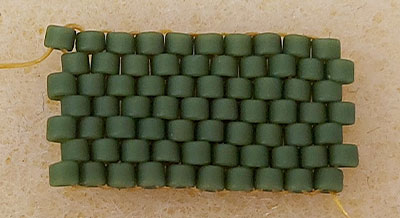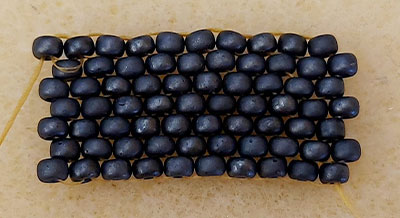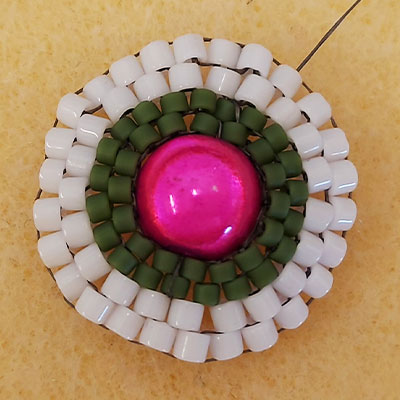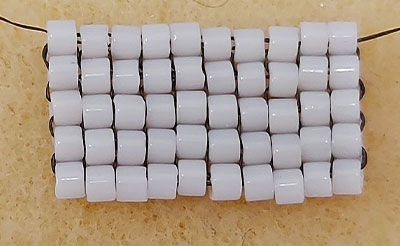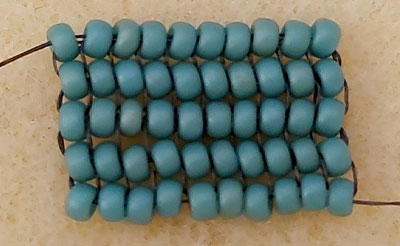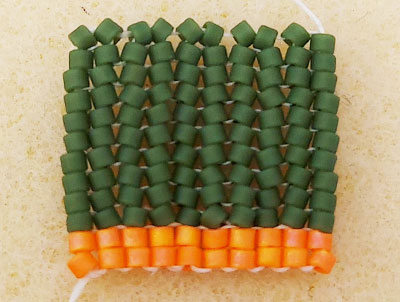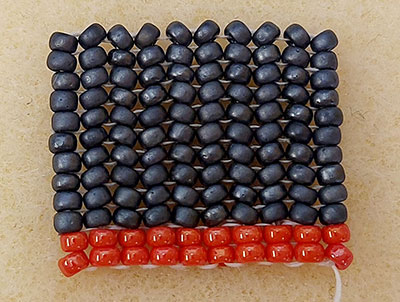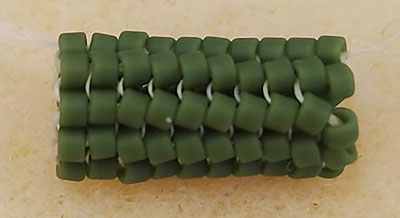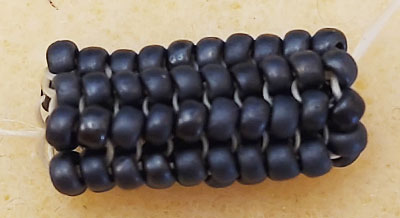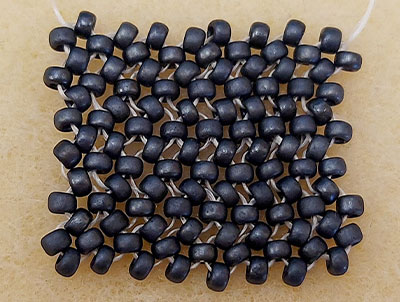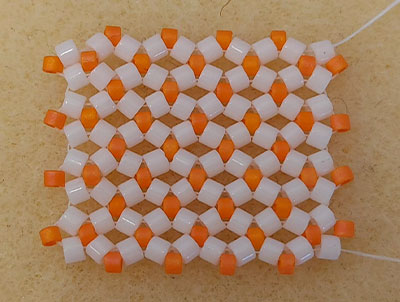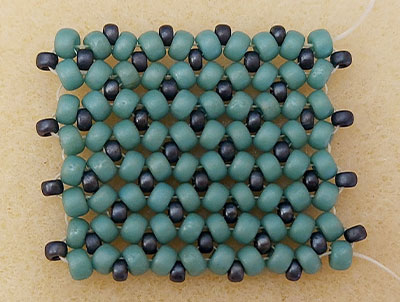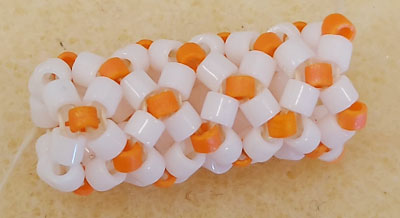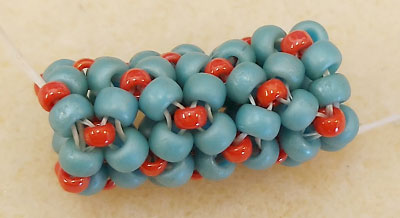| Miyuki Delicas Or Seeds - Which Bead Is Best for Your Bead Stitch? by Damaris Ramenaden |
When it comes to off-loom bead stitching, there is a huge variety of
different bead stitches you can use. All these stiches produce very different
patterns and textures. Some are great for producing flat, precise pieces,
some are great for more structural beaded ropes and tubes. And the Delica and Seed
beads you choose to stitch with can have a dramatic impact on your results.
For this blog, we're looking at some of the most common off-loom bead
stitches. We discuss how they’re used and how they can appear when worked up in
Miyuki Delicas or Miyuki Seed Beads.
It's important to note here that really there isn't a right or wrong delica
bead to use; it's more about the look you want to achieve. Some beads do yield
a better result and are easier to work with, but it's really the designer's choice
at the end of the day. Likewise, the choice of beading thread can also
dramatically impact on the same stitch with the same beads. Typically a softer,
more supple thread such as Nymo, KO or Miyuki is great for pieces that you want
to move easily. Whereas, FireLine and WildFire is good for pieces that require
more stiffness and uniformity.
Each of the samples below use either Miyuki Delica and Seed Beads usually
in 11/0 unless otherwise stated. We've also chosen colours that contrast
with each other, to help you see the pattern clearly. As many experienced
beaders will tell you, your choice of bead colour and finish can also have an impact on the overall appearance of
your bead stitches. So, please bear this in mind when making any choices.
Please note, the
instructions for each stitch are not given here. However, if you’re looking to
learn any of these techniques you can find them as free downloadable documents on www.beadworkersguild.com
Peyote Stitch
Peyote stitch is
one of the most popular and easiest bead stitches to learn. It's quick to do
and works forwards and backward along the row to produce a zig-zag effect. This
creates patterns with a great effect, simply by changing the colour of the
beads.
Even-Count Peyote (using
an even number of beads in the horizontal rows) is easier than Odd-Count Peyote
(using an odd number of beads in the horizontal row) due to the thread path at
the end of the rows. Which one you use depends on the pattern you want to
create with Peyote. If you want a pattern that has a centre column of beads
with a symmetrical design either side, such as chevrons or arrows, then
Odd-Count is better. Whereas simple vertical, horizontal or diagonal stripes
are fine worked in Even-Count.
In the samples
below, the thread path runs bottom to top, then top to bottom in a zig-zag
fashion, and so on.
|
|
beads used - 11/0 Miyuki Delica Miyuki Delicas are perfect for Even and Odd Count Peyote. This is
because their cylindrical shape allows the beads to 'click' next to each other
tightly and create a consistent and uniform piece of beadwork. Miyuki Delicas create
a clear, crisp pattern that holds the overall shape well. | beads used - 11/0 Miyuki Seed beads Although Miyuki Seed Beads are perfect for Even and Odd count peyote,
their round edges stop the beads sits as close to each other. This also means
the beads move a little next to each other; they almost have a ‘roll’ on them
that creates a looser and more organic look to the beadwork. |
Tubular Peyote Stitch
A Tubular Peyote
Stitch works in the same way as a regular Peyote Stitch but joins into a circle
at the end of the first row. The beads are then stitched around in a loop in
the same way, 'stepping up' at the end of each round to make sure the thread is
where it needs to be. A tube or rope is slowly formed as you add each row.
Tubular Peyote is
great for ropes, bezelling, beaded beads and beaded bead caps. Many people find
it useful working around a round mold such as a pencil, tooth or kebab stick,
or rubber tubing. This helps to keep the shape uniform and allows you to see
where to 'step-up' easier.
|
|
beads used - Miyuki 11/0 Delicas Miyuki Delicas create a very angular tube when stitched
together in this way. Sometimes the tube may not appear as uniform as usual as
the cylindrical shape of the beads means they can jar and jut against each
other. They can be good for creating more opportunities for additional
embellishments. This is because the bead holes are easier to access when
stitched this way. | beads used - Miyuki 11/0 Seed beads Miyuki Seed beads create a much rounder and softer rope when stitched
together in tubular form. Their rounded edges allow the beads to naturally
nestle closer to each other which in turn leads to a more supple and flexible
rope. The bead holes do allow
for additional embellishments, though you may find it less accessible for your
needle. |
Brick Stitch
Brick Stitch looks
similar to Peyote stitch, though when you work it you'll see the beads tun 90°
(the holes run from top to bottom, not side to side). The beads sit in top of
each other, instead of interlinked, just like bricks in a wall do. A brick
stick works by passing the thread through previous loops of thread, and not
through the existing beads. It may be easier to think of Brick Stitch in terms
of building the rows by working upwards or downwards. This differs to Peyote
where you build rows going side to side. You can increase and decrease rows of
Brick Stitch easily to make different shapes, such as animals and people.
|
|
beads used - Miyuki 11/0 Delicas Again, by stitching
the beads closely together, the cylindrical
shape of Miyuki Delicas create a crisp and uniform piece of beadwork. Patterns
and designs are clear and shapes are more defined. | beads used - Miyuki 11/0 Seed beads The Miyuki Seed beads again create a much looser and more organic
flat piece of beadwork. Their rounded edges can make shapes appear softer and
more natural, though patterns and designs may not be as clean as you'd like. |
Circular Brick Stitch
A Circular Brick
Stitch creates a circular design, usually around a central bead or focal.
Similar to Brick Stitch, the beads attach to the previous rows by passing
through the thread loops. It is easy to increase both the number of stitches
and the types of beads used as they are usually added as they fit. This means you
don't have to have an exact number of beads per round. Circular Brick Stitch is
a very versatile stitch as you can mix and match any beads in any size
throughout your design.
|
|
beads used - 11/0 Miyuki Delica (green), 10/0 Miyuki Delica (white) Miyuki Delicas are perfect for a Circular Brick Stitch. However, as the
circles increase you may find the gaps at the tops of the beads a little too
much for your design. The cylindrical shape does mean you can pass your needle
through the beads to embellish on the top easily. To improve your design maybe
create some beaded bridges or add some flat beads with stoppers on top (similar
to bead embroidery techniques). | beads used - 11/0 Miyuki Seed Beads (green), 8/0 Miyuki Seed Beads (salmon) Miyuki Seed beads nestle nicely next to each other in the initial rounds
of Circular Brick Stitch. If you choose to go with larger beads as the circles
increase, you should find the gaps are slightly less obvious than if you used Miyuki
Delicas. This is due to the roundness of the bead shape. You may find it
slightly trickier to embellish on top as the beads are tighter together. |
Square Stitch is
another stitch that works up into square or cubic patterns. This is different
to both Peyote and Brick Stitch, as this time the beads sit directly on top of
one another like a grid, not offset like brick work. Each bead anchors to the
bead below it and to the side of it as you add additional beads. Square Stitch
uses a lot of thread so it is easily seen. This is great if you're looking to
make something where the thread features heavily in the design. It's a good
stitch for creating bead woven fabric designs.
|
|
beads used - 11/0 Miyuki Delicas Miyuki Delicas sit closely together with this stitch and are great for
creating precise and clear designs. However, you may find it useful to cull
your Delicas before you use them as any odd shaped beads will be easily
spotted! Once stitched together, the Delicas create a soft and supple bead
fabric. If you want it slightly stiffer it is easy to pass back through each of
the rows to firm them up. | beads used - 11/0 Miyuki Seeds beads Miyuki Seed beads work well with this stitch too. However, your overall
design may not be quite as precise as Miyuki Delicas due to the round edges on
the beads. Much like Delicas, once they are all stitched together, you can
strengthen the weave by passing back through all the rows. Alternatively, you
can leave them looser for a more relaxed feel to your beadwork. |
Herringbone Stitch
Herringbone Stitch
(also known as Ndebele) involves stitching pairs of beads together to form
stacks, off an initial Ladder stitched row of beads. The stitch allows the
beads to naturally form 'v' shaped chevron or 'herringbone' designs.
Herringbone stitching goes up and down the stacks, so there must always be an
even number of stacks in your bead work. You can change the direction of the
'v' shapes by passing back down a stack then turning it 180°, effectively
working from underneath the bottom row. You can increase and decrease the size
of the stacks by changing the size of the beads. Additionally, you can add extra
embellishments in between the beads.
|
|
beads used - 11/0 Miyuki Delicas Here you can Miyuki Delicas work up to create even and tidy stacks of
herringbones. We've used a different colour to show the starting Ladder Stitch.
The cylinder shapes of Miyuki
Delicas create a stiffer piece of bead work. This shape holds its shape well
and remains uniform throughout the whole length. | beads used - Miyuki 11/0 Seed beads Miyuki Seed beads also create tidy and uniform bead stacks of
herringbones. We've used a different colour to show the starting Ladder Stitch.
The round shapes of Miyuki Seed beads allow them to nestle closely and form a
flexible woven piece. |
Tubular Herringbone Stitch
Tubular Herringbone
Stitch works in the same way as flat Herringbone stitch. Stacks of beads create
a starting round of Ladder stitch that forms a ring. The tubular shape is
slowly created as the bead stacks form and stitch to each other in each round.
This type of stitch creates a sinuous and flexible style of rope. It is
important to remember to 'step up' at the end of each round, otherwise the beadwork
can start to spiral.
|
|
beads used - 11/0 Miyuki Delicas In this stitch, the
cylindrical shape of the beads creates tight, uniform stacks that move easily
when worn. It acts in a similar way as a metal snake chain would. | beads used - 11/0 Miyuki Seed beads A tubular
herringbone rope made of Miyuki
Seed beads again forms a flexible rope. The bead stacks still sit closely
together, though the 'v' shape of the stacks is slightly less obvious with
these beads. |
Right Angle Weave
Beads stitched using Right Angle Weave (RAW) create tiny units that stitch
together in almost a figure of eight thread path. Typical Right Angle Weave
bead work use just 4 beads in each unit. However, you can make larger unit by
increasing the number of beads in each unit (as long as the number is divisible
by four to create equal units). Once stitched up, the piece can be further
embellished by adding beads and components. You can do this in the beads, on
the beads or by the side of the beads - it's super versatile and flexible!
|
|
beads used - 11/0 Miyuki Delicas Miyuki Delicas form quite a jagged and hard looking piece when stitched
using RAW. Their tube shapes don't always sit together easily and the pattern
created by the units isn't easy to see. Some additional embellishments may
fight for space between the Delica. This leads to a piece that doesn't lie flat
or comfortably, and has less flexibility. | beads used - 11/0 Miyuki Seed beads RAW patterns made using Miyuki Seed beads tend to be clearer and neater,
especially when worked with a sturdier thread such as FireLine. The feel of the
beadwork is more supple and comfortable. Any additional embellishments nestle
nicely next to or in between the beads. |
Flat Chenille Stitch
A Flat Chenille
Stitch works in rows. Adding, missing and cinching beads together to create the
tiny 'kisses' or 'flowers' design. This design works using two differently
sized beads that help define the pattern clearly. Creating stripes and Chevron
patterns involves clever placement of the larger beads that make up the netted
look. Chenille stitch is usually more common in tubular form. However, a Flat
Chenille Stitch creates a wonderfully smooth and silky bead fabric.
|
|
beads used - 11/0 Miyuki Delicas (orange), 10/0 Miyuki Delicas (white) Miyuki Delica beads create a very angular and square design when
stitched in this way - reminiscent of bathroom tile designs! The cylindrical
shape of the beads allows them to cinch together to form clear 'kisses'. However,
the overall piece of beadwork feels quite sturdy and not as flexible as if made
with seed beads. | beads used - 11/0 Miyuki Seed beads (gunmetal), 8/0 Seed beads (green) Flat Chenille Stitch is great for Seed beads as their round edges allow
the smaller beads to really get in close to the larger units. This feature also
allows the larger beads to nestle well with each other when cinched. The
beadwork itself feels very supple and fabric-like, and has a lovely drape for a
bracelet. |
Tubular Chenille Stitch
Tubular Chenille Stitch works in the same way as the Flat Chenille
Stitch, once the initial circle of beads has formed. Again, little 'kisses' or
'flowers' form using larger beads. The smaller beads create contrast and
texture changes too. The thread used here can also help with the rigidity and
stretch of your tube - soft, thin nylon threads make a more flexible and
stretchy rope.
|
|
beads used - 11/0 Miyuki Delicas (orange), 10/0 Miyuki Delicas (white) Miyuki Delicas again form a clear, if angular, pattern, with the smaller
beads really creating a strong contrast in both colour and texture. The shape
of the beads forms a rope that has clear gaps between the beads good if you want to add embellishments. The rope
that forms is fairly stiff with very little stretch, so may not be best for
more delicate work. | beads used - 11/0 Miyuki Seed beads (gunmetal), 8/0 Seed beads (red) Miyuki Seed beads create another sinuous beaded rope, with uniform and
clear patterns. The smaller beads allow the larger beads to sit closer
together, forming a much more cohesive design. The overall pattern has fewer gaps
in it, which can work well if you plan to have the beadwork cover an inner
core. |
Daisy Chain Stitch
Daisy Chain is one
of the simplest stitches for beads that creates a pretty flower design that is
open to many adaptations. It works using a small ring of beads with a larger
bead that then stitches into place. Or, as half a ring circling the larger
bead, then stitching the other half of the ring. A handful of small beads are
then threaded on to help space out the flower units.
It is usual to have a more rounded bead in the middle to help the outer
ring sit more evenly. However, in our examples we wanted to show what happens
if you use all Miyuki Delicas.
|
|
beads used - 11/0 Miyuki Delicas (green and orange) 10/0 Miyuki Delicas (white) When used in this pattern, Miyuki Delicas produce very cubic and angular
flower units. If you like the 'pixel art' or style of design then these are the
beads to use. The flowers can tend to jut out from one another as each edge of
the Delica doesn't sit comfortably next to the other. If you like the square
look of the flower units, you could try using seed beads as the joining beads,
to help the overall piece sit better. | beads used - 11/0 Miyuki Seed beads (red, gunmetal) 8/0 Miyuki Seed beads (green) The Miyuki Seed beads here create a much more organic and natural flower
shape. The joining red beads allow the flowers to sit easily against them. The
naturally round shape of the larger bead forms a more circular shape than if using
a Delica. However, to get an even better round flower unit a small Druk or round
bead is best. |
Generally speaking, flat bead stitches that have a circular or round
thread path work better with Seed beads (such as Daisy Chain, Right Angle
Weave). Whereas, flat bead stitches that go back and forth (such as Peyote,
Brick and Herringbone) tend to be better worked in Miyuki Delica beads. It
seems the rounded edge of the beads allows them to sit better next to each
other on a 'round' thread path. A vertical or horizontal thread path allows the
Miyuki Delica beads to 'click' together to form a tightly woven piece.
For tubular bead stitches, those that work by going round the tube shape
horizontally or as a circular stitch (such as Tubular Peyote and Cubic Right
Angle Weave) tend to be better with Miyuki Seed Beads. This is because the
round edges form the tube shape easier. Tube shapes that form vertically (such
as Tubular Herringbone) tend to be better with Miyuki Delicas. This is because
their cylindrical shapes help create uniform stacks.
The exception to the rule is the Chenille Stitch in either flat or
tubular form - both of these work well with both Miyuki Delica and Seed beads.
If you're looking
to learn any of these techniques you can find many of these stitches as free
downloadable documents on www.beadworkersguild.com.

